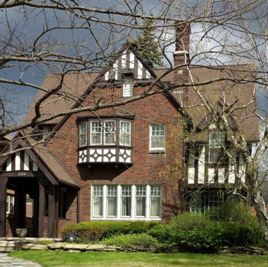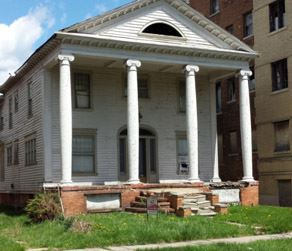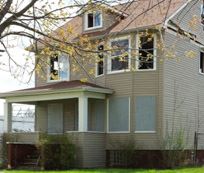HISTORIC INTEGRITY
Does your house have "historic integrity?" How much of your house still looks like it did when it was built? The more original architectural features and the more original materials that are still intact, the greater is its historic integrity. However, a house can lose its integrity all together, if it loses most of its original features.
Maintaining historic integrity is the essence of historic preservation.
Historic Integrity = Historic Preservation
The Elements of Historic Integrity
- Original form. Additions or partial demolitions change the original form.
- Original siding. Application of artificial siding covers or replaces the original siding.
- Original doors and windows. Removal of original doors and windows is a loss of original material, and it fundamentally changes the original design of the house.
- Original porch. Changing or enclosing a porch is like an addition or demolition. Original features of a porch, such as its columns, railings, and porticos are part of the original design and are original materials. When these are lost, changed, or obscured, integrity is lost.
- Original soffits and eave boards. Aluminum or vinyl sheathing that cover the original material reduces integrity.
- Original ornamentation. Removal, alteration, or covering of ornamentation reduces historic integrity. Similarly, non-original ornamentation reduces integrity. A wide range of ornamentation appears on Detroit houses such as rafter tails on eaves, window hoods, decorative stone work, and cornices and moldings, or fancy siding shingles (sometimes called "fish scale" shingles). There are many other examples that reflect the imagination of architects and builders.
- Original color scheme. Paint colors that were not used at the time of construction reduce integrity. Most historic architectural styles have used a range of colors, however.
A Good Example
This house in the Detroit Boston Edison Historic District has high integrity. The house retains the original form and massing: there has been no addition or partial demolition. Original windows are in place, with a 6/1 arrangement of windowpanes. Original ornamental elements are in place and are highlighted by the paint scheme. Paint color is appropriate to the house style. The porch is intact, with its distinctive roof line, columns and ornamentation matching the house gables. The original chimney has not been modified. |
|
Integrity Matters
Integrity = Investment Value. People are more attracted to historic houses that have high integrity, because they are more interesting. Attraction enhances market value. "Home improvement" that sacrifices historic integrity reduces property value, because the house loses some of the distinctive features that made it attractive. Since home value is important for both owners and their neighbors, preserving historic integrity matters to them.
Integrity = Historic Preservation. Keeping the historic integrity of a house is the essence of historic preservation. Since historic preservation is a value in and of itself for many owners, historic integrity matters to them.
Neighborhood Integrity
When a neighborhood still looks like it did originally, it also has historic integrity. Neighborhood integrity also matters for the same reasons as for individual houses. While the value of a house depends on its own historic integrity and condition, its value also depends on its surrounding neighborhood. If the neighborhood has historic integrity, this historic ambience adds value to the entire neighborhood and to each house in it.
Like a house, a neighborhood can lose its historic integrity. It can lose it because many of the houses have lost integrity. It also can lose it because the streetscapes themselves have been changed in ways that sacrifice integrity. Changes to streets and curbs, sidewalks, and lighting may be made to lose their original character.
"Condition" is Not the Same as "Integrity"
Even though a house is run down, it can still have high integrity, if it still retains its original character and materials. While historic integrity applies both to the exterior and the interior of houses, the historic building ordinance only applies to exteriors.
High Integrity, Poor Condition
These two houses in Detroit have high integrity, even though they are in poor condition. They need a great deal of repair and restoration. Their historic elements are, however, mostly intact. The original windows are in both houses. Both have their original columns, and the porch structures remain unchanged. Although the brick house has a column missing, the others can be repaired and are a clear model for replacing the missing one. The white Greek revival house not only has its Greek columns, it has all of the Greek ornamentation, notably on the pediment above. It also has its original wood siding. The original shutters are in place on the second story of the brick house. While the first story shutters are missing, the originals are clear models for replacing them. The paint has deteriorated on both houses, as have the entry steps. Both houses need extensive maintenance, repair, and restoration. Nonetheless, since the historic elements largely survive, the houses have a great deal of historic integrity. |
|
Low Integrity, Good Condition
By contrast, this Detroit house is in excellent condition, but it has lost a great deal of its historic integrity. Extensive "home improvement" and "remodeling" have removed most of the historic elements. All of the original doors and windows are gone. On the first floor, one window has been remodeled from its original configuration into a large picture window: not only does this destroy the original windows, it also changes the style of the house and throws the façade out of symmetry. Artificial siding has been installed over the entire house. The porch columns have been replaced with plastic ones that probably are thinner than the originals. The shutters on the house are not original, being of artificial material, and they are not of the same dimensions as the windows. |
|
Low Integrity, Poor Condition
Of course, a house can both lose its historic integrity and be in poor condition. This Detroit house lost its historic integrity to "home improvement" before it was abandoned and stripped. |
|
Historic Districts Protect Integrity & Value
Protecting historic integrity is the principal reason for historic districts. Cities enact historic preservation ordinances to protect their historic buildings. Owners of historic buildings then petition to form historic districts under those ordinances.
Historic districts protect homeowners' investments by requiring that both individual houses and entire neighborhoods retain historic integrity. The principal reason for historic districts is historic preservation of historic structures and neighborhoods. The investment protection for individual homeowners comes as a by-product. Historic districts protect against changes that degrade or destroy the historic neighborhood and that suppress property values.
When the integrity of a neighborhood is protected, a homeowner will feel more confident in making large investments of time and money in restoring an historic home because they know that value will be supported in that neighborhood. The compromise is only that the homeowner also has to keep restoration work within the historic guidelines for that historic district.
For Detroit historic district guidelines, see this page. For Secretary of Interior Standards and Guidelines for Rehabilitation of Historic Buildings, see this page.






